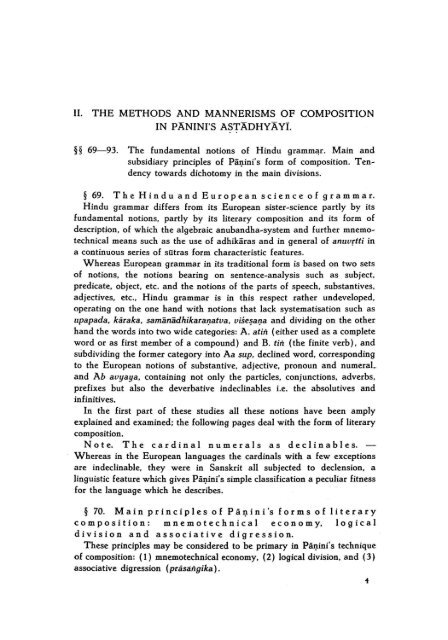Studies on Panini's grammar - DWC
Studies on Panini's grammar - DWC
Studies on Panini's grammar - DWC
Create successful ePaper yourself
Turn your PDF publications into a flip-book with our unique Google optimized e-Paper software.
11. THE METHOOS AND MANNERISMS OF COMPOSITION<br />
IN PANINI'S ASTÄDHYÄYI.<br />
§§ 69-93. The fundamental noti<strong>on</strong>s of Hindu gramm~r. Main and<br />
subsidiary principles of PäJ}.ini's form of compositi<strong>on</strong>. Ten~<br />
dency towards dichotomy in the main divisi<strong>on</strong>s.<br />
§ 69. Th e H in d u a n d Eu rop e a n sc i e n c e 0 f 9 ram mar.<br />
Hindu <strong>grammar</strong> di Hers from its European sister~science partly by its<br />
fundamental noti<strong>on</strong>s, partly by its literary compositi<strong>on</strong> and its form of<br />
descripti<strong>on</strong>, of which the algebraic anubandha~system and further mnemo~<br />
technicaI means such as the use of adhikäras and in general of anuvrtti in<br />
a c<strong>on</strong>tinuous series of sutras form characteristic features.<br />
Whereas European <strong>grammar</strong> in its traditi<strong>on</strong>al form is based <strong>on</strong> two sets<br />
of noti<strong>on</strong>s, the noti<strong>on</strong>s bearing <strong>on</strong> sentence~analysis such as subject,<br />
predicate, object, etc. and the noti<strong>on</strong>s of the parts of speech, substantives,<br />
adjectives, etc., Hindu gram mar is in this respect rather undeveloped,<br />
operating <strong>on</strong> the <strong>on</strong>e hand with noti<strong>on</strong>s that lack systematisati<strong>on</strong> such as<br />
upapada, käraka, samänädhikara1J.atva, vise~a1J.a and dividing <strong>on</strong> the other<br />
hand the words into two wide categories: A. atiTi (either used as a complete<br />
word or as first member of a compound) and B. tiTi (the finite verb), and<br />
sltbdividing the former category into Aa sup. declined word, corresp<strong>on</strong>ding<br />
to the European noti<strong>on</strong>s of substantive, adjective, pr<strong>on</strong>oun and numeral,.<br />
and Ab avyaya, c<strong>on</strong>taining not <strong>on</strong>ly the particles, c<strong>on</strong>juncti<strong>on</strong>s, adverbs,<br />
prefixes but also the deverbative indeclinables i.e. the absolutives and<br />
infinitives.<br />
In the first part of these studies all these noti<strong>on</strong>s have been amply<br />
explained and examined; the following pages deal with the form of literary<br />
compositi<strong>on</strong>.<br />
Not e. T h e c a r din a I n u mer a I sas dec I i n a bie s. -<br />
Whereas in the European languages the cardinals with a few excepti<strong>on</strong>s<br />
are indeclinable, they were in Sanskrit all subjected to declensi<strong>on</strong>, a<br />
linguistic feature which gives PäJ}.ini's simple classificati<strong>on</strong> a peculiar fitness<br />
for the language which he describes.<br />
§ 70. M a i n p rin c i p les 0 f P ä J}. i n i 's f 0 r m sof I i ter a r y<br />
co m pos i t i<strong>on</strong>: m n e mot e c h n i c a I e c<strong>on</strong> 0 m y, log i c a I<br />
d i v i s i<strong>on</strong> a n das s 0 c i a t i v e d i 9 r e s s i<strong>on</strong>.<br />
These principles may be c<strong>on</strong>sidered to be primary in PäJ}.ini' s technique<br />
of compositi<strong>on</strong>: (1) mnemotechnical ec<strong>on</strong>omy, (2) logical divisi<strong>on</strong>, and (3)<br />
associative digressi<strong>on</strong> (präsaTigika).<br />
..
















